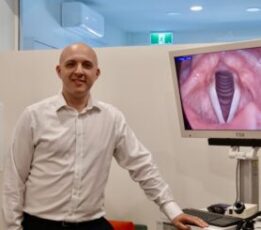Unilateral Vocal Fold Paralysis or Paresis
Unilateral Vocal Fold Paralysis is diagnosed when one of the vocal folds is not moving or is moving very little due to a loss of nerve signal to the muscles that move that vocal fold. This can cause a weak and breathy voice as both vocal folds are not coming together effectively to vibrate during voicing. Coughing and swallowing may also be affected. It is distinct from other causes of vocal fold immobility such as disorders affecting the joint of the vocal fold (e.g. arthritis)
How is it caused?
Vocal Fold Paralysis results from damage to the nerve(s) that supplies movement to the vocal fold (e.g. Recurrent laryngeal nerve). This can be due to surgery to the head and neck area(e.g. Thyroid Surgery, Cervical Spine Surgery, Carotid Artery Surgery), inflammation due to a viral illness or from pressure on the nerve supplying the vocal fold by a mass in the neck or chest. However,the cause is often ‘idiopathic’ or unknown.
How is it treated?
In many cases nerve function may return spontaneously if the nerve is intact. It is important to remember that this can sometimes take up to a year or more. There are no treatments to recover nerve function, however voice therapy can help to improve the voice
Voice therapy focuses on improving voice strength and stamina with techniques to improve voice projection, breath support and general efficiency of voice production.
Your Speech Pathologist can also provide strategies to make coughing and swallowing easier.
What about surgical treatments?
In a number of cases, patients can benefit from ‘augmentation’ techniques. In their simplest form, this can involve a small injection (of your own fat or a synthetic bio compatible substance) deep/behind the non-functioning vocal fold to ‘plump’ it up and aid the remaining mobile vocal fold in achieving closure. Some of these in jectables may be temporary and will often be absorbed/ dissipate over a few months but can give better voice while waiting to see whether vocal fold movement recovers, and also given an indication as to the potential for further vocal benefit with a longer lasting injection or other ‘permanent’ technique. Fat injection can last for months to years but outcomes seem to be variable. Other agents such as Prolaryn Plus®are used for long term bulking up, lasting a few years.
Other re-positioning techniques, such as Thyroplasty, can medialise the non-working vocal fold. This is a more permanent surgical option usually reserved for those patients who are unlikely to regain nerve function or when the gap is too big for injectables. This surgical technique wedges the paralysed vocal fold towards the midline to assist vocal fold closure, using synthetic materials (e.g. Silastic or Gore-Tex®) placed through an incision in the neck.Occasionally, additional procedures are performed to help re-align the cartilaginous part of the vocal fold (e.g. Arytenoid Adduction or Adduction Arytenopexy), or restore tension in the vocal fold itself (e.g. Cricothyroid subluxation)
In a few select cases where irreversible surgical or traumatic damage to the nerve is known, the option of using another nearby nerve in the neck as a graft to re-estabilish a signal and some tone in the paralysed vocal fold, is used.
Following diagnosis of a unilateral vocal fold paralysis, your Ear Nose & Throat Surgeon and Speech Pathologist will discuss appropriate treatment options with you.







